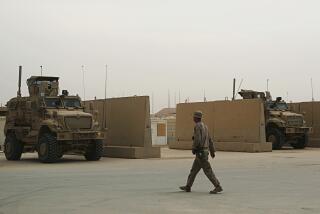In Gulf, All Eyes Are on the Calendar
DHAHRAN, Saudi Arabia â The line in the sand that President Bush drew in August has become a circle on the calendar, and across the Persian Gulf soldiers and civilians alike are counting down the days to Jan. 15, as though warned of the precise moment a great storm would strike.
With each passing day, the tension gnaws a little deeper, and the preparations for war, carried out with a strange businesslike finality, grow more intense. The waiting game, the posturing, the psychological warfare will soon be overtaken by the deadline--and, most believe, the twilight zone between war and peace will have finally run its course. It is a scenario that U.S. troops greet with something approaching a sense of relief.
âI look forward to the deadline,â said Spec. Jim Law, 19, of Roanoke, Tex. âIt gives us a chance to get this thing kicked off and start thinking about home. Basically, the press is saying this will be a short war. I hope theyâre right.â
Even though attempts are under way in a dozen capitals to find a peaceful solution to the gulf crisis, Jan. 15 looms so large in everyoneâs thoughts and conversations in Saudi Arabiaâs Eastern Province that it is impossible to conceive of anything but a nation marching inexorably toward war.
One newspaper runs a daily countdown to the U.N. deadline for Iraq to withdraw from Kuwait--â14 Days to K-Day,â it said Tuesday--as if ticking off the shopping days left till Christmas.
In the briefing room at the Armyâs Support Command, the days remaining until Jan. 15 are changed every morning: D-16 . . . D-15 . . . D-14. Gradually the âthreatconâ--the alert status of U.S. troops--is edging upward, from alpha, the lowest level, toward delta, the highest.
The countdown toward possible war is occurring against a backdrop of apprehension, but certainly not panic. The departure of expatriates from the potential war zone remains a trickle, not an exodus, and the U.S. State Department has only suggested that dependents should consider leaving the Eastern Province voluntarily if they feel concerned. The American population in Saudi Arabia has fallen to about 21,000 from 26,000 since August.
In anticipation of a large-scale departure of foreigners, however, Saudia, the national airline, has added 41 international flights, to start next Wednesday. Travel agents throughout the gulf report unusually heavy business, and some flights to Europe already are fully booked for the next two weeks.
In Bahrain, where the British government is issuing gas masks to its citizens, the 9,000-member British community has been cut in half since dependents were ordered home. Several other countries, including Ireland and Sweden, also have told their dependents to leave.
The U.S. population in the gulf is about 30,000, and diplomatic sources said plans to evacuate them by sea have been drawn up if war makes the departure necessary.
The Saudis themselves act surprisingly relaxed, apparently convinced that any war would not spread much beyond Kuwait and its borders. They generally ignore the civil defense alert sirens that are being tested weekly in the kingdomâs cities, and the arrival of the 1991 models of automobiles seems to have caused more excitement than the announcement that two more U.S. battle groups, led by the carriers America and Theodore Roosevelt, are steaming toward the gulf.
The flight of capital, about $8 billion from Saudi Arabia after Iraqâs invasion, has stopped, and most of the funds have been transferred back to the kingdom, banker Waheeb Benzagr said.
âThere will be war, but it will come from Turkey, not the Eastern Province,â said businessman Mohammed Sanea, offering an unlikely but widely held belief that somehow the whole problem will get fixed without real Saudi involvement or risk.
Shops in nearby Kobar are doing a booming business selling T-shirts with displays of the American or British flags and the words: âThese Colors Donât Run.â Russian-made gas masks are offered at drugstores for $128 each, and sales are brisk.
At the Dhahran International Hotel, where many journalists and military personnel are staying, the newest member of the hotel staff is a British defense consultant, hired to advise on reducing risks in the event of attack.
Out back of the hotel, carpenters are building three studios for the television networks, each with a backdrop of palm trees. Journalists huff and puff by the nearby pool, doing sit-ups and pushups as part of an unprecedented military requirement that anyone participating in combat pools must meet minimum standards of physical fitness.
For the 300,000 U.S. troops here, the Jan. 15 deadline approaches amid a continuing buildup of personnel and equipment that is the biggest since the Vietnam War. Saudi ports are jammed with tanks and trucks and artillery guns, the highways are clogged with convoys moving north toward the front, and jet fighters flash through the skies, night and day, on training missions that carry them to within minutes of Kuwait.
âThe worst part of being here has been the waiting,â said Marine Maj. Bill Lucenta of Wellesley, Mass. âEveryoneâs ready to go, and weâd rather get on with whatever it is weâre going to do.â
Many U.S. troops view Jan. 15 as a political, not military, deadline. Yet what happens in the next two weeks, they believe, will determine the destiny of their mission. A war will be fought or a settlement reached. Either way, they figure, the next countdown will be the one on calendars that short-timers keep when they are headed home.
More to Read
Sign up for Essential California
The most important California stories and recommendations in your inbox every morning.
You may occasionally receive promotional content from the Los Angeles Times.










